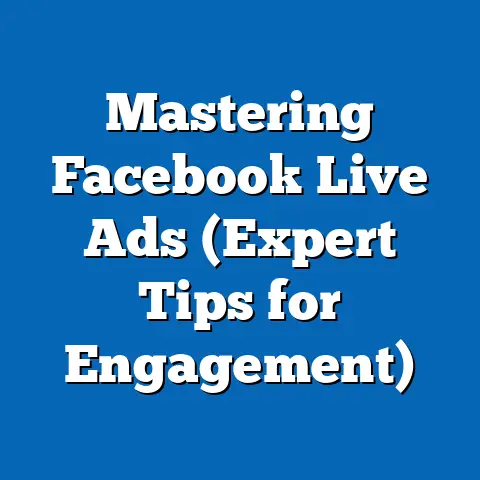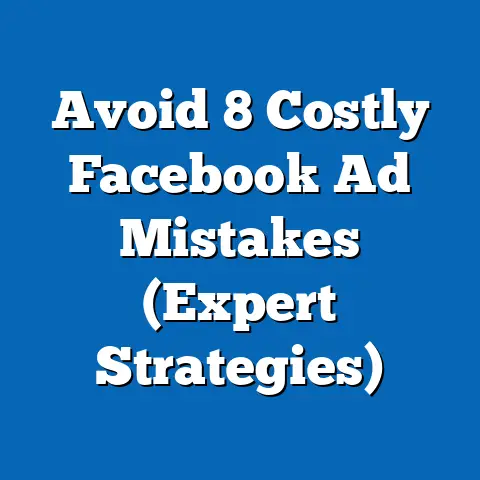Maximize Impact with 1200 x 900 Facebook Ads (Pro Tips)
Facebook advertising is a powerhouse, and I’ve seen firsthand how it can transform businesses. But let’s be real, it’s not just about throwing money at ads and hoping for the best. Especially when you’re targeting a unique audience like children and their parents, you need a strategy that’s both creative and data-driven. The world of social media wields immense influence over children’s preferences and parental choices, making it crucial to craft ads that not only grab attention but also resonate deeply with this demographic. That’s where the 1200 x 900 pixel ad size comes into play – an optimal format for creating visually stunning and impactful Facebook ads.
These aren’t just any ads; they’re carefully crafted messages designed to spark interest, build trust, and ultimately drive action. In this article, I’m going to share some pro tips that will help you create Facebook ads that truly connect with children and their parents, turning potential customers into loyal fans. We’ll dive into everything from understanding your audience to A/B testing your campaigns. So, buckle up, and let’s get started on making your Facebook ads a resounding success!
Section 1: Understanding Your Audience
When it comes to advertising to children’s products or services on Facebook, it’s not enough to just think about the kids. You’ve got a dual audience: the children themselves and their parents. I learned this the hard way early in my career. I was working on a campaign for a new line of educational toys, and I focused solely on what I thought kids would find appealing – bright colors, cartoon characters, and catchy slogans. The ads looked great, but the sales were dismal. It wasn’t until I started paying attention to what parents were looking for – quality, safety, and educational value – that things started to turn around.
The Dual Audience: Children and Parents
Children are drawn to fun, excitement, and visual appeal. Parents, on the other hand, are concerned with safety, educational value, and the overall well-being of their children. Your ads need to speak to both of these audiences simultaneously.
Demographic Insights
Understanding the demographics of your audience is crucial. For children, consider age ranges, interests, and online behavior. What are their favorite games, TV shows, and online personalities? For parents, think about their age, income, education level, and values. What are their concerns and aspirations for their children?
Facebook Insights is your friend here. Dig into the data to uncover valuable information about your target audience. I often use it to see what pages and interests my ideal customers are engaging with. This helps me tailor my ad targeting and messaging for maximum impact.
Creating Relatable Content
The key is to create content that resonates with children while also appealing to their parents’ values and purchasing decisions. For example, an ad for a new video game could highlight the fun and excitement of the gameplay while also emphasizing the educational benefits, such as improved problem-solving skills or creativity.
One of the most successful campaigns I ran involved a series of ads that featured real kids playing with the product. The ads were authentic, engaging, and relatable, and they resonated with both children and their parents. We saw a significant increase in sales and brand awareness as a result.
Takeaway: Always remember that you’re advertising to two distinct audiences: children and their parents. Do your research, understand their needs and desires, and create content that speaks to both of them.
Section 2: Crafting the Perfect Visuals
In the world of Facebook advertising, visuals are king, especially when you’re trying to capture the attention of children. A 1200 x 900 ad gives you plenty of space to work with, but it’s important to use that space wisely. I’ve seen ads that are visually stunning but completely miss the mark because they don’t resonate with the target audience.
The Power of High-Quality Visuals
High-quality visuals are essential for capturing attention and making a lasting impression. Think vibrant colors, engaging imagery, and appropriate design elements that attract children’s attention. But remember, it’s not just about being visually appealing; it’s about being relevant and age-appropriate.
Selecting the Right Imagery
When selecting imagery, think about what will resonate with children. Cartoons, animated characters, and photos of real kids can all be effective. But it’s important to choose imagery that is appropriate for the age range you’re targeting. An ad for toddlers should look very different from an ad for pre-teens.
I once worked on a campaign for a children’s clothing brand, and we decided to use photos of real kids wearing the clothes in everyday situations. The photos were natural, authentic, and relatable, and they resonated with both children and their parents. We saw a significant increase in engagement and sales as a result.
Playful Fonts and Graphics
Playful fonts and graphics can enhance the visual appeal of your ads without overwhelming the viewer. Choose fonts that are easy to read and graphics that are fun and engaging. But be careful not to overdo it. Too many fonts or graphics can make your ad look cluttered and confusing.
Maintaining Brand Consistency
It’s important to maintain brand consistency through colors and logos while still appealing to a younger audience. Use your brand colors and logo in your ads, but don’t be afraid to experiment with different design elements to make them more appealing to children.
Takeaway: Don’t underestimate the power of visuals. Choose high-quality imagery, playful fonts and graphics, and maintain brand consistency to create ads that capture attention and make a lasting impression.
Section 3: Writing Compelling Copy
Visuals may grab attention, but it’s the copy that seals the deal. When you’re targeting children and their parents, your copy needs to be concise, engaging, and persuasive. I’ve learned that the best ads speak directly to both audiences, addressing their needs and desires in a way that is both informative and entertaining.
Concise and Engaging Copy
Your copy should be concise and easy to understand, using language that resonates with both children and their parents. Avoid jargon and technical terms. Instead, focus on the benefits of your product or service and how it can improve their lives.
Headlines and Body Text
Your headline should be catchy and attention-grabbing, while your body text should provide more detail about your product or service. Use strong verbs and descriptive language to paint a picture in the reader’s mind.
The Power of Storytelling
Storytelling is a powerful tool for engaging children and their parents. Create a narrative that captures the imagination of children and encourages them to engage with your brand. For example, an ad for a new toy could tell the story of a child who uses the toy to go on an exciting adventure.
I once worked on a campaign for a children’s book, and we created a series of ads that told the story of the book’s main character. The ads were engaging, entertaining, and informative, and they resonated with both children and their parents. We saw a significant increase in book sales as a result.
Effective Calls-to-Action (CTAs)
Your CTAs should prompt both children and their parents to take the desired action, such as visiting a website or making a purchase. Use strong verbs and clear language to tell them exactly what you want them to do.
Examples of effective CTAs include:
- “Learn More”
- “Shop Now”
- “Get Started”
- “Sign Up Today”
Takeaway: Your copy is just as important as your visuals. Use concise and engaging language, tell a compelling story, and include effective CTAs to drive action.
Section 4: A/B Testing and Optimization
Creating a great Facebook ad is just the first step. To truly maximize your impact, you need to continuously test and optimize your campaigns. A/B testing is a powerful tool for determining what works and what doesn’t, and it’s essential for improving your engagement and conversion rates over time.
What is A/B Testing?
A/B testing, also known as split testing, involves creating two versions of an ad – A and B – and showing them to different segments of your audience. By comparing the performance of the two ads, you can determine which one is more effective.
Setting Up A/B Tests
Setting up A/B tests for 1200 x 900 ads targeted at children’s products is relatively straightforward. In Facebook Ads Manager, you can create a new campaign and select the “A/B Test” objective. From there, you can choose which elements to test, such as visuals, CTAs, or copy variations.
Elements to Test
Some of the most common elements to test in your Facebook ads include:
- Visuals: Try different images, videos, or animations to see which ones resonate best with your audience.
- CTAs: Experiment with different CTAs to see which ones drive the most clicks and conversions.
- Copy Variations: Test different headlines, body text, and ad descriptions to see which ones are most engaging.
- Targeting Options: Try different targeting options, such as interests, demographics, or behaviors, to see which ones yield the best results.
Analyzing Results
Once your A/B tests have run for a sufficient amount of time, it’s time to analyze the results. Look at metrics such as click-through rate (CTR), conversion rate, and cost per acquisition (CPA) to determine which ad performed better.
I always make sure to have a statistically significant sample size before drawing any conclusions. You want to be confident that the results you’re seeing are real and not just due to random chance.
Continuous Optimization
The key to successful A/B testing is continuous optimization. Once you’ve identified a winning ad, don’t just sit back and relax. Keep testing and tweaking your ads to see if you can improve their performance even further.
Takeaway: A/B testing is a powerful tool for maximizing the effectiveness of your Facebook ads. Set up tests, analyze the results, and continuously optimize your campaigns to improve engagement and conversion rates over time.
Conclusion
Creating impactful Facebook ads aimed at children and their parents requires a blend of creativity, strategic thinking, and data-driven optimization. Remember to always start with a deep understanding of your audience, crafting visuals and copy that resonate with both children and their parents. Don’t be afraid to experiment with different design elements and messaging strategies, and always be sure to include clear and compelling calls-to-action.
But the real magic happens when you start A/B testing your campaigns. By continuously testing and optimizing your ads, you can identify what works and what doesn’t, and you can improve your engagement and conversion rates over time.
So, what are you waiting for? Start applying these pro tips in your next Facebook ad campaign and see the measurable results for yourself. With the right strategy and execution, you can create Facebook ads that not only capture attention but also drive meaningful engagement and ultimately boost your bottom line.
Now go out there and create some amazing ads! I’m confident that with these tips, you’ll be well on your way to Facebook advertising success. Good luck!





